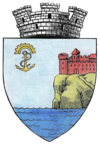Hirsova
| Hârșova | ||
|---|---|---|
| Town | ||
 |
||
|
||
|
Location of Hârșova in Romania
|
||
| Coordinates: 44°41′0″N 27°57′7″E / 44.68333°N 27.95194°ECoordinates: 44°41′0″N 27°57′7″E / 44.68333°N 27.95194°E | ||
| Country |
|
|
| County | Constanța County | |
| Status | Town | |
| Component villages | Vadu Oii | |
| Government | ||
| • Mayor | Viorel Ionescu (Alliance of Liberals and Democrats) | |
| Population | ||
| • Total |
|
|
| Time zone | EET (UTC+2) | |
| • Summer (DST) | EEST (UTC+3) | |
| Climate | Cfa | |
| Website | http://www.primaria-harsova.ro/ | |
Hârșova (also spelled Hîrșova; Romanian pronunciation: [ˈhɨrʃova]; Bulgarian: Хърсово, Harsovo) is a town located on the right bank of the Danube, in Constanța County, Romania.
The village of Vadu Oii is administered by the town. The village is linked with Giurgeni commune over the Danube via the Giurgeni-Vadu Oii Bridge.
The relationship between the current name of Hârșova and the ancient name of the city, Carsium has long been a matter of debate among historians and linguists. According to Iorgu Iordan the ancient name may have been kept under the influence of the Slavic word Круш, cliff, rock.
The current name may also derive from the ancient Slavic god Hârs (Хърс) and Slavic suffix "-ova" and it is still under debate whether it is in any way linked with the ancient name, or perhaps a common proto-indo-european root related to "ecstasy"/"desire", ultimately also related to the vedic rta and avestan arta.
In ancient times, a Roman settlement named Carsium, belonging to the Scythia Minor province, lay on the current site of the town.
In 1853, The Times of London reported that "Hirsova"
is defended by a fortified castle, and has a garrison of abouit 2,000 men. This place was taken by the Russians in 1809 and 1828. Though small, it is of considerable importance from its position on the very spot where the Berchicha returns to the Danube. . . . It is in many parts inundated, but has good pasturage for the excellent horses which constitute the sole wealth of the Tartars who inhabit it.
...
Wikipedia


